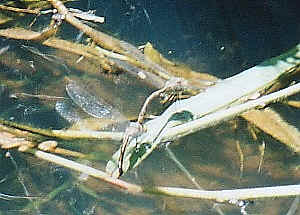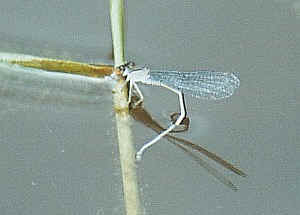Mating and Reproduction in Odonata
In this page we describe the typical sequence of stages during mating and reproductions of dragonflies and damselflies. Their reproduction and associated behaviour is unique among the animal world. The behaviour is complex but universal within dragonflies and damselflies, although with difference spices there could be some minor variations.
Territorial Behaviour
Some dragonflies and damselflies species show very strong territory behaviour while some species do not. A territory is defined as a fixed area that an animal defends against intrusion from other of its own species. In dragonflies and damselflies the territory will usually be a good egg-laying site.


- Above pictures show the hovering Yellow Emperor and the perching Bog Skimmer guarding their territory.
The male dragonflies and damselflies will return to their breeding ground and stay there when they mature and ready for mating. Most male Skimmer Dragonflies perch on their favorite spot and overlook their territory. The male Hawker and Emerald will usually fly, non-stop within a fixed path over their territory. When there is the intruders of the same species male (sometime other species as well), the territory holder will driver away the intruder, by showing better body colour, better flying skill, larger in size or some other advantages. Sometime the very close and violent contact are occurred. The males will stay in their territory and wait for the female.
In most dragonflies and some damselflies, females only visit their breeding site to mate and lay eggs. They will leave the breeding sit after laying eggs, until not batch of eggs are ready.
When the female enter the male territory (or when a male meet a female in the non-territory species), they will start the next mating sequence, the courtship and recognition.
Courtship and Recognition
- Courtship and recognition includes the male showing his oviposition site to the female. By courtship, the male and female can make sure they are the same species and are suitable mates. The female may reject the mating if she thinks the oviposition site is not good enough. There are different courtship pattern for different species.


- The above pictures show a female come into a male territory, they just start the courtship and recognition.
- For some species, after the female enters the male territory, she will immediately be grasped and clasped by the male and the couple will mate, no courtship can be seen.
-
For the non-territory species, there will also be the courtship and recognition stage. They may swarm and several males may pursuit the same female. This is common in damselflies. - If the female do not accept the male, various signal will
be made, depends on species. The most common is the downward curving of her
abdomen. If the female indicates acceptance, the male will grasp her thorax
with his legs, i.e., start the
next mating sequence, Grasping and Clasping.
Grasping and Clasping
The male grasps the female head or thorax and curves his abdomen to clasp her prothorax or head with his anal appendages to form the tandem pair. This action usually takes less than a second.
-

- The picture shows a male overtakes a female from above. They may do this in air or when the female is on vegetation. Sometime the male may force the female to land or even knock flying female onto the water.


- The above pictures show the anal appendages at the abdomen tips of a Australian Flatwing Damselfly male and a Blue Skimmer Dragonfly male. Damselflies have a pair of inferior appendages and a pair superior appendages, i.e.., totally four appendages. Dragonflies have a pair of superior appendages and a single inferior one, totally three. Those specialized appendages are used to clasp the female for copulation. In damselflies the male clasp the prothorax of the female. In dragonflies the male clasp the female back of the head. Those appendages will only fit into the same species female.
- At this stage, the couple is said to be 'in tandem position'.
Tandem
-

- Tandem position is the male seizure of the female head
(dragonflies) or prothorax (damselflies). The male and female will be in tandem for a while, from seconds to minutes.
They may fly in tandem or find a suitable place to settle.
Intramale Sperm translocation
All insect males have their genital opening for sperm at the ninth abdominal segment. Dragonflies/damselflies males have (beside the first genitalia) their secondary genitalia, which is the accessory organ on the second abdominal. Sperm is moved from the first genitalia into the secondary genitalia just before copulation.

- The picture shows the male transferring sperm to his genitalia (or accessory genitalia). The male bend his abdomen forward so that the first genitalia touches his secondary genitalia. This may take several seconds.
- For dragonflies the males do this before he finds a female. For damselflies the males do this immediately afterwards.
Copulation invitation

- After forming a tandem and the sperm in the male secondary genitalia is ready, male damselfly invites copulation by wing flapping and flexing the abdomen. The female responds with bending up her abdomen to the genitalia of the male and form the wheel position.
- Dragonflies usually start copulation in flight, the male swing up the female.
Copulation - Wheel Position


- The female then curls her abdomen forwards to contact with the secondary genitalia in order to receive sperm. The male and female form the heart shape wheel and it is known as Wheel Position. Notice that in damselfly male is holding by female's neck (prothorax) while in dragonfly is holding the back her head.

- Most damselflies settle and perched for copulation. Most dragonflies start copulation in flight, some may continue in flight and some may settle. Settle copulation usually last longer, from minutes to hours. Air copulation may last only a few seconds.
- For some species, it is found that before transferring his sperm, the male will remove the existing sperm from the female genitalia which is from earlier mate, then replace it with his own.
Tandem after Copulation
After the copulation the couple may separate or remain in tandem, depends on species.

- A long period of Tandem Position may be occurred after copulation. The couple may be at rest or in flight and there is no genital contact. The reason could be the male waiting for the female for the readiness of oviposition. By holding the female he can make sure she does not mate with other male before laying eggs.
Guarding Oviposition
The male often accompanies the female when she oviposits. Eggs are laid in two general ways, some species females, they have their sharp ovipositor which can cut into plants and deposit eggs into there. Some species do not have their sharp ovipositor and simply drop their eggs into waters.


- There are different ways of male accompaniment, some species are still in tandem, with the female laying eggs into the plants materials, using her sharp ovipositor to cut open the plants materials. This is common in many damselflies and some Hawker Dragonflies species.

- Some species in tandem with the female dipping her abdomen tip quickly into the water surface, wash away the eggs by water. This is can be seen in some skimmer dragonflies.
- Some species the male hovers around and guard the female when she is laying eggs, which is common in many territorial skimmers, such as the Bog Skimmers.

- However, some species female may oviposits alone. This is common in most Hawker and some damselflies.
- The adult male and female may live 7-10 weeks. A female may lay several batches of eggs. Each batch she may lay a few hundreds to a few thousands eggs, depends on species. Those eggs may hatch after 5-40 days, depend on species, temperature and other conditions. Generally there are about 10-15 instars stages, may take one to ten years living in waters, depends on species. Then they emergence and become adults. A new cycle is started.
Questions for Discussion
How the complex mating behaviour pattern in dragonflies and damselflies evolved?
There is still not known exactly why the dragonfly male have two sets of reproduction organs and why they evolved such a complex mating behaviour.
The secondary genitalia is used as the intromittent organ during copulation and have similar function as the pedipalps of a male spiders introduce sperm into females.
All predator males have a common problem - how to avoid being eaten by the females before, during and after mating. To a female point of view, there is benefit and no disadvantage to prey on the male unless the male has contribution to bring up their offspring.
Male dragonflies and damselflies successfully solved this problem by clasping the female with their anal appendages before, during and after mating. We seldom see male eaten by female. This could be one of the reasons that they evolved such such a complex mating behaviour.
Male spiders also solved this problem, although not as good as the dragonflies, as we know male spider is still sometime eaten by female. Male spiders evolved their pedipalps to hold their sperm so that they can run away a bit more easier after mating.
Praying Mantids, the relatively young order compares with spiders and dragonflies, did not have enough time to evolved a solution yet. So praying mantids male is known to be eaten by female from time to time.
This could be the reason why some assassin bug species breed parthenogentically, i.e., reproduce by female without mating. Some assassin bug species male help to look after their youngs.
